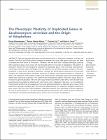| dc.contributor.author | FARES, MARIO | en |
| dc.date.accessioned | 2017-03-27T10:57:17Z | |
| dc.date.available | 2017-03-27T10:57:17Z | |
| dc.date.created | 2017 | en |
| dc.date.issued | 2017 | en |
| dc.date.submitted | 2017 | en |
| dc.identifier.citation | Mattenberger F, Sabater-Muñoz B, Toft C, Fares M.A, The phenotypic plasticity of duplicated genes in Saccharomyces cerevisiae and the origin of adaptations, G3: Genes, Genomes, Genetics, 7, 1, 2017, 63 - 75 | en |
| dc.identifier.other | Y | en |
| dc.identifier.uri | http://hdl.handle.net/2262/79697 | |
| dc.description.abstract | Gene and genome duplication are the major sources of biological innovations in plants and animals. Functional and transcriptional divergence between the copies after gene duplication has been considered the main driver of innovations . However, here we show that increased phenotypic plasticity after duplication plays a more major role than thought before in the origin of adaptations. We perform an exhaustive analysis of the transcriptional alterations of duplicated genes in the unicellular eukaryote Saccharomyces cerevisiae when challenged with five different environmental stresses. Analysis of the transcriptomes of yeast shows that gene duplication increases the transcriptional response to environmental changes, with duplicated genes exhibiting signatures of adaptive transcriptional patterns in response to stress. The mechanism of duplication matters, with whole-genome duplicates being more transcriptionally altered than small-scale duplicates. The predominant transcriptional pattern follows the classic theory of evolution by gene duplication; with one gene copy remaining unaltered under stress, while its sister copy presents large transcriptional plasticity and a prominent role in adaptation. Moreover, we find additional transcriptional profiles that are suggestive of neo- and subfunctionalization of duplicate gene copies. These patterns are strongly correlated with the functional dependencies and sequence divergence profiles of gene copies. We show that, unlike singletons, duplicates respond more specifically to stress, supporting the role of natural selection in the transcriptional plasticity of duplicates. Our results reveal the underlying transcriptional complexity of duplicated genes and its role in the origin of adaptations. | en |
| dc.description.sponsorship | We thank members of the Fares laboratory for careful reading and discussion of the results in the manuscript. We are also grateful to colleagues at Trinity College for helpful discussions. This work was supported by a grant from the Spanish Ministerio de Economía y Competitividad (reference: BFU2015-66073-P) and a grant (reference: ACOMP/2015/026) from the local government Consellería de Educación Investigación, Cultura y Deporte, Generalitat Valenciana to M.A.F. C.T. was supported by a grant Juan de la Cierva from the Spanish Ministerio de Economía y Competitividad (reference: JCA-2012-14056). | en |
| dc.format.extent | 63 | en |
| dc.format.extent | 75 | en |
| dc.relation.ispartofseries | G3: Genes, Genomes, Genetics | en |
| dc.relation.ispartofseries | 7 | en |
| dc.relation.ispartofseries | 1 | en |
| dc.rights | Y | en |
| dc.subject | eukaryote Saccharomyces cerevisiae | en |
| dc.subject.lcsh | eukaryote Saccharomyces cerevisiae | en |
| dc.title | The phenotypic plasticity of duplicated genes in Saccharomyces cerevisiae and the origin of adaptations | en |
| dc.type | Journal Article | en |
| dc.type.supercollection | scholarly_publications | en |
| dc.type.supercollection | refereed_publications | en |
| dc.identifier.peoplefinderurl | http://people.tcd.ie/faresm | en |
| dc.identifier.rssinternalid | 155439 | en |
| dc.identifier.doi | http://dx.doi.org/10.1534/g3.116.035329 | en |
| dc.rights.ecaccessrights | openAccess | |
| dc.identifier.rssuri | https://www.scopus.com/inward/record.uri?eid=2-s2.0-85008472783&doi=10.1534%2fg3.116.035329&partnerID=40&md5=80a201775548d560b8d193a372acf93e | en |




